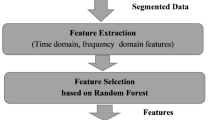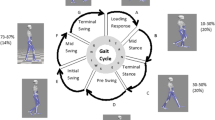Abstract
Human Activity Recognition (HAR) is a sensor-based observation of human action. HAR is used to monitor the health issues associated with human activities. HAR is used to monitor human health, observation of elderly people, and fitness tracking activity. HAR is an advanced application of Machine Learning (ML), and Artificial Intelligence is used to detect various human-related activities. In this study, we have described a few physical exercises, using Random Forest (RF) classifier. In that case, we have obtained an accuracy of 99%. We have also used a few feature selection algorithms such as Equilibrium Algorithm (EQ), Marine Predators algorithm (MPA), Tree Growth Algorithm (TGA), Artificial Butterfly Algorithm (ABO), and Bat Algorithm (BA) to reduce computational complexity and time. These algorithms were tested using a KU-HAR dataset, which provided 97%, 98%, 99.8%, 97%, and 97% accuracy in classification for the dataset used for testing. This study aims to understand the extent to which supervised machine learning algorithms can achieve well and how it affects the accuracy of sensor recognition. This approach will help researchers conduct more research in the future on the recognition of human exercise activities.
Access this chapter
Tax calculation will be finalised at checkout
Purchases are for personal use only
Similar content being viewed by others
References
Vrigkas, M., Nikou, C., Kakadiaris, I.A.: A review of human activity recognition methods. Front. Robot. AI 2, 28 (2015)
Zebin, T., Scully, P.J., Ozanyan, K.B.: Evaluation of supervised classification algorithms for human activity recognition with inertial sensors. In: 2017 IEEE Sensors, pp. 1–3. https://doi.org/10.1109/ICSENS.2017.8234222
Ogbuabor, G., La, R.: Human activity recognition for healthcare using smartphones. In: Proceedings of the 2018 10th International Conference on Machine Learning and Computing, pp. 41–46 (2018)
Huang, Y.-C., Yi, C.-W., Peng, W.-C., Lin, H.-C., Huang, C.-Y.: A study on multiple wearable sensors for activity recognition. In: IEEE Conference on Dependable and Secure Computing, pp. 449–452 (2017)
Wang, C., Zhang, W.: Activity recognition based on smartphone and dual-tree complex wavelet transform. In: 2015 8th International Symposium on Computational Intelligence and Design (ISCID), vol. 2, pp. 267–270 (2015)
Kirchner, J., Faghih-Naini, S., Bisgin, P., Fischer, G.: Sensor selection for classification of physical activity in long-term wearable devices. In: IEEE Sensors, pp. 1–4 (2018)
Zebin, T., Scully, P.J., Ozanyan, K.B.: Inertial sensor-based modelling of human activity classes: Feature extraction and multi-sensor data fusion using machine learning algorithms. In: e-Health 360°. Springer, pp. 306–314 (2017)
Kańtoch, E.: Human activity recognition for physical rehabilitation using wearable sensors fusion and artificial neural networks. Comput. Cardiol. (CinC) 2017, 1–4 (2017)
Bayat, A., Pomplun, M., Tran, D.A.: A study on human activity recognition using accelerometer data from smartphones. Procedia Comput. Sci. 34, 450–457 (2014)
Casale, P., Pujol, O., Radeva, P.: Human activity recognition from accelerometer data using a wearable device, vol. 6669, p. 296. https://doi.org/10.1007/978-3-642-21257-4_36
Lee, S.-M., Yoon, S.M., Cho, H.: Human activity recognition from accelerometer data using convolutional neural network. In: 2017 IEEE International Conference on Big Data and Smart Computing (BigComp), pp. 131–134. https://doi.org/10.1109/BIGCOMP.2017.7881728
Chandini, U.: A machine learning based activity recognition for ambient assisted living. Int. J. Future Rev. Comput. Sci. Commun. Eng. 4(3) (2018)
Nahid, A.-A., Sikder, N., Rafi, I.: KU-HAR: an open dataset for human activity recognition 5 (2021). https://doi.org/10.17632/45f952y38r.5
Dehkordi, M.B., Zaraki, A., Setchi, R.: Feature extraction and feature selection in smartphone-based activity recognition. Procedia Comput. Sci. 176, 2655–2664 (2020). https://doi.org/10.1016/j.procs.2020.09.301
Nour, M., Polat, K.: automatic classification of hypertension types based on personal features by machine learning algorithms. Math. Probl. Eng. 2020, e2742781 (2020). https://doi.org/10.1155/2020/2742781
Rasekh, A., Chen, C.-A., Lu, Y.: Human activity recognition using smartphone (2014). http://arxiv.org/abs/1401.8212. Accessed 2 Sept 2021
Gao, Y., Zhou, Y., Luo, Q.: An efficient binary equilibrium optimizer algorithm for feature selection. IEEE Access 8, 140936–140963 (2020). https://doi.org/10.1109/ACCESS.2020.3013617
Abd Elminaam, D.S., Nabil, A., Ibraheem, S.A., Houssein, E.H.: An efficient marine predators algorithm for feature selection. IEEE Access 9, 60136–60153 (2021)
Nakamura, R.Y., Pereira, L.A., Costa, K.A., Rodrigues, D., Papa, J.P., Yang, X.-S.: BBA: a binary bat algorithm for feature selection. In: 2012 25th SIBGRAPI conference on graphics, patterns and images, pp. 291–297 (2021)
Chand, S., Wagner, M.: Evolutionary many-objective optimization: a quick-start guide. Surv. Oper. Res. Manag. Sci. 20(2), 35–42 (2015). https://doi.org/10.1016/j.sorms.2015.08.001
Rodrigues, D., de Albuquerque, V.H.C., Papa, J.P.: A multi-objective artificial butterfly optimization approach for feature selection. Appl. Soft Comput. 94, 106442 (2020). https://doi.org/10.1016/j.asoc.2020.106442
Too, J., Abdullah, A.R., Mohd Saad, N., Mohd Ali, N.: Feature selection based on binary tree growth algorithm for the classification of myoelectric signals. Machines 6(4), 65 (2018)
Sikder, N., Chowdhury, M.S., Arif, A.M.S., Nahid, A.-A.: Human activity recognition using multichannel convolutional neural network. In: 2019 5th International Conference on Advances in Electrical Engineering (ICAEE), pp. 560–565 (2019)
Author information
Authors and Affiliations
Corresponding author
Editor information
Editors and Affiliations
Rights and permissions
Copyright information
© 2022 The Author(s), under exclusive license to Springer Nature Singapore Pte Ltd.
About this paper
Cite this paper
Mondal, P.K., Awal, M.A., Nahid, AA. (2022). Machine-Learning Based Physical Exercise Identification with Heuristic Optimized Features Prioritization. In: Hossain, S., Hossain, M.S., Kaiser, M.S., Majumder, S.P., Ray, K. (eds) Proceedings of International Conference on Fourth Industrial Revolution and Beyond 2021 . Lecture Notes in Networks and Systems, vol 437. Springer, Singapore. https://doi.org/10.1007/978-981-19-2445-3_4
Download citation
DOI: https://doi.org/10.1007/978-981-19-2445-3_4
Published:
Publisher Name: Springer, Singapore
Print ISBN: 978-981-19-2444-6
Online ISBN: 978-981-19-2445-3
eBook Packages: Intelligent Technologies and RoboticsIntelligent Technologies and Robotics (R0)




